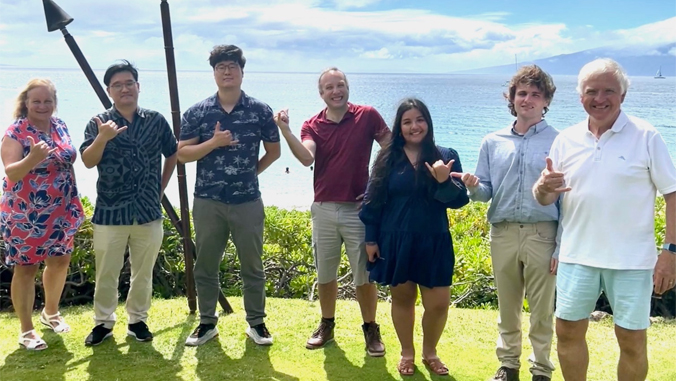
A complex software framework that advances scientific knowledge of high energy density (HED) materials and processes has been developed by University of Hawaiʻi researchers. The development is key to a wide range of disciplines, including renewable energy, medicine and more.
The software provides mathematical models for many diverse applications, including exploding liquid droplets heated by an X-ray laser at the nanosecond (billionth of a second) timescale. In this application, the software focuses on the interactions between cooler portions of the liquid droplets and the column of heated HED droplet material, for experiments being carried out at the world’s brightest X-ray laser at the U.S. Department of Energy’s Stanford Linear Accelerator Center (SLAC) National Laboratory.
Droplet targets and X-ray lasers are used to understand very small objects that are critical in the study of topics in biology, design of materials, medicine, energy research and more. The extremely bright and fast flashes of light are how scientists are able to take actual pictures and movies of the tiniest and speediest processes on Earth.
An example of SLAC energy research is solar-based renewable energy. Learning how water is split into protons and oxygen in photosynthetic organisms by using light is critical for designing artificial systems that are important for solar-based renewable energy. Another example of applying the modeling in medicine is when studying an enzyme in blood known as hemoglobin. Hemoglobin allows oxygen to be carried around our bodies and gives red blood cells their distinctive color. The software helps to optimize the experimental setup that in turn allows scientists to study the small and fast physical processes in great detail.
The “Pacific Island Structured-Adaptive Mesh Refinement with Arbitrary Lagrangian-Eulerian” (PISALE) software was supported by a three-year, $591,000 grant from the U.S. Department of Energy.
“The importance of this project resides in the ability of the PISALE code to model very complex physics at disparate length and time scales using mathematical techniques such as dynamically evolving adaptive meshes,” said Alice Koniges, project lead and graduate faculty in the UH Mānoa Information and Computer Sciences Department. “Our PISALE code is unique in its ability to provide physics-based models of these intricate fluid/air interactions in three dimensions. Understanding how the droplet heated by the XFEL beam explodes and interacts with the following droplet is critical in determining the effective repetition rate. If the following droplet is distorted it must be skipped, which reduces the repetition rate for data collection. Better repetition rate gives scientists a tool for extremely fast processes.”
Training budding scientists
The project is also an opportunity to train the next generation of researchers to work with numerical softwares on modern high-performance computing platforms. Stanford University graduate student in mechanical engineering Claudia Parisuana is modeling hydrogen and water droplet explosions using the PISALE code.
“This project is an amazing opportunity for me because I am able to create a 3D model of liquid droplets exploding for the first time,” Parisuana said. “This capability is going to help us advance the field of HED science towards high repetition rate experiments in a unique way.”
Expanding research findings
To complement the existing PISALE capabilities, the team is working on improving the surface tension package. Surface tension is the physical force that keeps liquid, such as raindrops, together in the air. Graduate students are using this model to see how a heated droplet interacts with following droplets, which have not yet been heated, to see if they get distorted. UH Mānoa Department of Mathematics graduate student Jack McKee is developing the code for this package and working on new models.
“It’s rare that you can take all this really abstract math I’ve been learning and apply it to something concrete like this,” McKee said. “I always love seeing the final results too, even when it’s just a little blob wobbling on the screen. That wobble took a lot of effort!”

